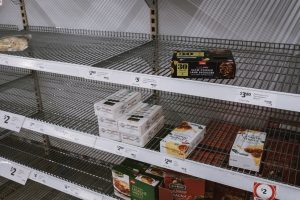The global supply chain crisis is not going away anytime soon, and as the holiday shopping season ramps up, it could get worse. The far-reaching effects are playing out across the country, with long lines and even longer wait times for items that used to be easy to get.
There are many different reasons for the supply chain crisis and many different ways it impacts consumers’ daily lives, from rising costs to added difficulty securing Christmas presents.
The shortage of semiconductor chips, which are used in everything from cars to toys and consumer electronics, has become a major international issue. Marvell Technologies CEO Matt Murphy recently told CNBC that he expects that shortage to continue well into 2022, and global experts are concerned that the brewing tensions between China and the U.S. could exacerbate the problem.
Additionally, major ports of entry in the U.S. such as the Ports of Los Angeles and Long Beach in Southern California are facing large logjams of ships with goods ready to be imported into the U.S., and despite actions from President Joe Biden to nationalize and ensure those ports run 24 hours per day, those logjams persist.
How can you take this national issue and localize it to your area of coverage? Here is what you need to know to make this story relevant to your community.
Pay attention to what the experts and politicians are saying
The supply chain crisis has become a hot-button political issue, and key members of the Biden administration are often asked about it in media appearances. Additionally, press secretary Jen Psaki answers questions about it nearly every day in her briefings. Aside from Psaki as well as Biden himself, other figures to pay attention to include Vice President Kamala Harris and Secretary of Transportation Pete Buttigeig. In Congress, one important entity to keep an eye on is the House Transportation and Infrastructure committee, with Rep. Peter DeFazio (D-Ore.) as its chair and Rep. Sam Graves (R-Mo.) as its ranking Republican member.
Biden has made several public speeches about the supply chain in recent weeks, highlighted by his Oct. 13 announcement that the U.S.’s two largest commercial trading ports of entry, the ports of Los Angeles and Long Beach, will run 24 hours per day with the help of the federal government.
However, Chris Burroughs, vice president of government affairs for the Transportation Intermediaries Association, told Roll Call recently that there is no “easy fix” for the supply chain crisis and Biden’s attempt to open the ports nonstop would not have much of an effect without additional measures in place.
“If you don’t have the drivers, don’t have the equipment, or real estate or warehouse space, it doesn’t matter how much ports are open,” Burroughs said. “If you’re lacking those four things, you’re going to have a problem.”
Buttigeig also told Yahoo Finance recently that although the recently passed Bipartisan Infrastructure Package should have some long-term stabilizing effects on the supply chain, short-term disruptions will persist as long as the coronavirus pandemic continues to be a factor.
Understand consumer impact of inflation
Inflation is another major issue right now, one that goes hand-in-hand with the supply chain as lower supply leads to higher prices. Fortunately, there are ways to track inflationary trends on a localized level using publicly available government data.
Two good places to start are the Bureau of Labor Statistics and your local chamber of commerce. The BLS publishes a treasure trove of data that is localized to many regions of the U.S., including inflation rates in what is labeled a consumer price index (CPI). Below is the year-over-year CPI percentage change for the greater Phoenix area as of October 2021:
The BLS also provides the full dataset, which can be broken down by specific types of consumer goods, here.
Local chambers of commerce are better for small business trends. The Greater Phoenix Chamber of Commerce, for instance, publishes data concerning local sales tax revenue, small business hiring trends, and local unemployment rates from the Arizona state government as well as the University of Arizona Economic and Business Research Center.
Explore how small businesses in your area are dealing with the supply chain crunch
Without the backing of large corporations to help sort out logistics when it comes to clogged supply chains, small businesses have been some of the hardest hit in terms of lack of goods and rising costs. The Reynolds Center reached out to two local retail businesses in Phoenix – clothing store Phoenix General and Wildlings Toy Boutique – to ask how they have been affected by supply chain issues.
Joshua Hahn, co-owner of Phoenix General, said that his store had been able to avoid some bigger logistical issues because his vendors do not heavily rely on mass production.
“Our vendors are pretty good at sourcing things locally, or wherever they are in the country,” Hahn said.
Shipping costs, however, are another story, as Hahn saw a “significant” increase this year. Jenn Mawcinitt, the founder and owner of Wildlings, has seen shipping prices go up as well. Because toys are more often mass produced overseas, Mawcinitt said she has dealt with major backlogs and inventory issues since Wildlings opened in August.
“We’ve had issues with products being back ordered, so that we’re not able to get it and then we’ve also had shipping delays,” Mawcinitt said. “So even though companies have product in their warehouse, they don’t have enough staff to get it shipped out in a timely manner. So we’ve been impacted by both.”
Mawcinitt said she has also had to implement some price increases in some cases because of how manufacturers have raised their prices on inventory over the past several months.
However, both Hahn and Mawcinitt said the sales at their respective stores have done well in recent weeks, and especially over the traditionally busy holiday shopping weekend immediately following Thanksgiving. Both businesses also offer online sales, and Hahn and Mawcinitt credited that component as boosting their overall performance.
Anecdotes like these can help reporters flesh out the data they present, providing tangible examples to charts like this one showing the current strength of consumer demand.











